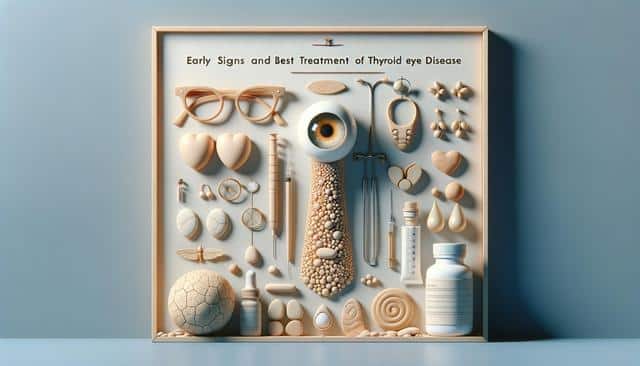Understanding Early Signs and Treatment Options for Thyroid Eye Disease
When you spot signs that show up fast—like pain, a lump, or a feel that is off—it may help to act quick. The best care plans start when you know what to look for and who to call. This guide will walk you through signs, steps, and ways to heal.

What Is Thyroid Eye Disease?
Thyroid Eye Disease (TED), also known as Graves’ orbitopathy or thyroid-associated ophthalmopathy, is an autoimmune condition that affects the tissues around the eyes. It is commonly linked to hyperthyroidism, particularly Graves’ disease, but can also occur in individuals with normal or low thyroid function. TED causes inflammation and swelling in the muscles and fatty tissues behind the eyes, leading to noticeable symptoms that can impact vision and appearance.
The condition typically progresses in two phases: an active phase where symptoms worsen, followed by an inactive phase where inflammation subsides but lasting effects may persist. Understanding TED is essential to recognizing the early signs and seeking care before complications arise. Some people may develop mild symptoms, while others experience more severe effects that require medical intervention. Knowing what to watch for can help ensure timely treatment and reduce the risk of permanent damage.
Early Signs You Shouldn’t Ignore
The early signs of Thyroid Eye Disease can be subtle at first but often become more obvious as the condition progresses. One of the most recognizable symptoms is a change in the eyes’ appearance or function. If caught early, many complications associated with TED can be managed more effectively.
Common early symptoms include:
- Redness or swelling around the eyes
- Dry or gritty sensation in the eyes
- Bulging eyes (proptosis)
- Double vision (diplopia)
- Light sensitivity (photophobia)
- Eye pain or pressure, especially when moving the eyes
- A feeling of tightness or fullness in the eyelids
In some cases, these symptoms may be mistaken for allergies or eye strain, which can delay proper diagnosis. If you notice any of these signs, particularly if you also have a known thyroid condition, consulting an eye specialist or endocrinologist is a wise step. Early detection plays a key role in preventing further eye damage and planning treatment effectively.
How Diagnosis Is Made
Diagnosing Thyroid Eye Disease involves a combination of patient history, physical examination, and imaging tests. Your healthcare provider will ask about symptoms, current thyroid function, and any recent changes in vision or eye appearance. A thorough eye exam will help assess how the condition is affecting your sight and eye movement.
Diagnostic tools may include:
- Thyroid function blood tests to measure hormone levels
- CT or MRI scans to evaluate muscle and tissue changes behind the eyes
- Ocular ultrasound to detect swelling or fluid buildup
- Visual field testing to monitor peripheral vision loss
Since TED is often associated with autoimmune thyroid conditions, it’s important that both an ophthalmologist and an endocrinologist are involved in the diagnosis and care. A multidisciplinary approach ensures that the treatment addresses both the eye-related and systemic aspects of the disease.
Available Treatment Options
Treatment for Thyroid Eye Disease varies depending on the severity of symptoms and the stage of the disease. In the active phase, the goal is to reduce inflammation and protect vision. During the inactive phase, treatment may focus more on correcting any lasting physical changes or vision problems.
Common treatment approaches include:
- Artificial tears and ointments to relieve dryness and irritation
- Selenium supplements, which may help reduce mild symptoms
- Anti-inflammatory medications such as corticosteroids
- Immunosuppressive therapies for moderate to severe cases
- Radiation therapy in select cases to reduce inflammation
- Surgical options to correct eye bulging, double vision, or eyelid position
Some individuals may also benefit from lifestyle adjustments, such as quitting smoking, which has been shown to exacerbate TED symptoms. In recent years, targeted therapies have emerged that focus on blocking specific pathways involved in inflammation and tissue growth, offering new hope for those with more advanced cases.
Monitoring and Long-Term Management
After the initial treatment phase, ongoing monitoring is essential to manage Thyroid Eye Disease effectively. Since the condition can fluctuate, regular check-ups help ensure that any changes are detected early. Long-term management focuses on preserving vision, maintaining eye comfort, and addressing cosmetic concerns if necessary.
Key components of long-term care include:
- Routine eye exams to track changes in vision and eye structure
- Thyroid hormone level checks to maintain overall health
- Use of protective eyewear to shield sensitive eyes from wind and light
- Supportive therapies such as prisms in glasses to correct double vision
- Referral to specialists for reconstructive surgery if needed
Living with TED can be challenging, but with proper care and support, most individuals can manage their symptoms and maintain their quality of life. Support groups and counseling may also be helpful for those coping with the emotional effects of visible changes in appearance or prolonged treatment.
Conclusion: Taking Control of Eye Health with Awareness
Recognizing the early signs of Thyroid Eye Disease and seeking timely treatment can make a significant difference in outcomes. Whether you’re managing an existing thyroid condition or just starting to notice changes in your eyes, staying informed is the first step toward effective care. By working closely with healthcare professionals and following a tailored treatment plan, you can take proactive steps to protect your vision and overall well-being.